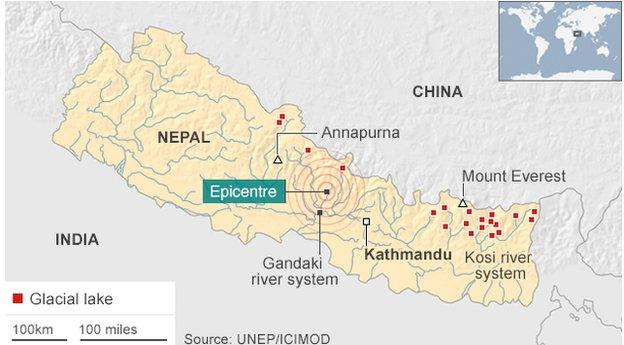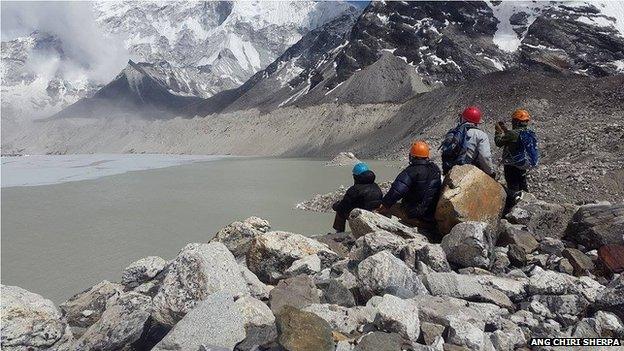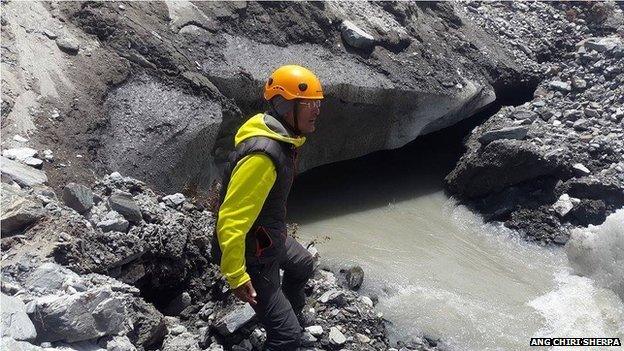Nepal quake: Everest Sherpas warn of mountain risks
- Published

Nepal has more than 2,300 glacial lakes
Everest Sherpas say they have seen potentially dangerous changes in their landscape after Nepal's 7.8-magnitude earthquake and aftershocks.
They say they are living in fear of flooding and tumbling rock and ice because they have witnessed cracks in the ground and in glaciers.
Some glacial lakes have sunk underground with their outlets appearing at new places.
With temperatures increasing and the monsoon on the way, anxiety is rising.

Glacial lakes at risk of flooding following the 25 April earthquake
Hundreds of people from Sherpa villages fled to higher ground for safety on Monday night after a small glacial lake burst its banks, sweeping away two small bridges and a cowshed. It caused rumours that a major glacial lake had flooded.

Sherpas are members of an ethnic community that descended from Tibet hundreds of years ago - they use Sherpa as their surnames
A large number tend to be employed in helping climbers in expeditions or guiding trekkers, while others run lodges and tea houses for trekkers and mountaineers

Nepal has more than 2,300 glacial lakes and the most feared is Imja.
Government officials say a helicopter survey showed Imja was intact, but they admit a ground study of the area is yet to be done.

Imja Lake - the most feared - is intact, according to government officials
Locals say they are relieved about Imja but uncomfortable about other changes they have observed.
During a field visit this week, a team from Sherpa villages found ice and debris in a place they should not have been.
"That was a place where we used to see certain flowers bloom," said Ang Chiri Sherpa, chairman of the Sagarmatha buffer zone users' group.
"But when we went to see what had happened, we saw an unusual, small glacier-like body of ice and soil and rock debris that could potentially fall on our village.
"We have no idea where this potentially dangerous thing came from."

Sherpas have said new outlets have emerged from glacial lakes
With the summer season sending temperatures up and monsoon rains approaching, locals say they are increasingly worried.
"Rising temperatures mean glacier meltdown will accelerate and rains will mean moraines [rock and sediment deposited by a glacier] could become loose," said Tshering Sherpa, an official whose non-governmental organisation manages Everest base camp and the climbing route to the highest peak.
"All these could multiply the risk of outbursts, more so because the earthquake and continued tremors may have made the moraines of glacial lakes already weak.
"And then we have the recent horrifying experience of a lake breaking on Monday, even if it was a small one."
Most locals in the villages in the Everest region are still sleeping outdoors for fear of aftershocks and they say the concern over possible destabilised glacial lakes and glaciers are making them feel worse.
Pasang Sherpa, a lodge owner in Namche said the cries of women and children on Monday night still ring in her ears.

Sherpas have found visible cracks following the earthquake and subsequent aftershocks
"We were all holding torches and running uphill crying and shouting in fear, it was miserable."
Scientists say they have not seen any evidence of risks so far but they also warn that things could change in these shaky times.
"Except for this little event of a lake which somehow released all its waters on Monday, there has been no evidence [of risk] as such," said Walter Immerzeel, assistant professor of physical geography at Utrecht University in the Netherlands.
"But I think it's a fair concern on the part of Sherpas [because] you have those moraine dams which block those lakes and they can be destabilised by earthquakes and aftershocks."
Dr Immerzeel was in a team that recently produced research on Everest glaciers published this week in The Cryosphere journal of the European Geosciences Union (EGU).
"Avalanches and earthquakes can breach the dams, causing catastrophic floods that can result in river flows 100 times greater in the Kosi basin," the EGU said.
The Kosi basin stretches from the Everest region in the north to the Kosi river that joins the Ganges in India across the border in eastern Nepal.
Although the government and scientists say they have seen no immediate threat, members of the Sherpa community argue say their focus has been limited to the Imja glacial lake.
"So many other glacial lakes have formed in recent years and none of them have been studied, all they talk about is Imja," said Ang Chiri Sherpa.
Rishiram Sharma, head of the government agency responsible for monitoring and taking care of the glaciers and glacial lakes in the Nepalese Himalayas, said his office was trying to co-ordinate with other government agencies for an urgent field study.
"We understand the frustration of the Sherpa community and we will conduct a ground study at the earliest," he said.
The Sherpas from villages right below the glacial lakes and glaciers say they have formed a committee to monitor the threat themselves.
"Our committee will now make a dam to protect a village that was hit by Monday's flood from a glacial lake and then we will prepare a database of all the risky glacial lakes including those around the Khumbu glacier," said Ang Chiri Sherpa.
"We have heard enough of the government and foreign agencies' plans and projects to help us."